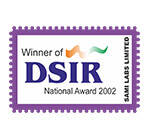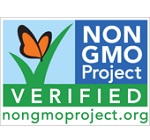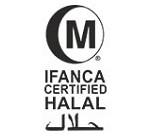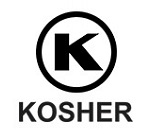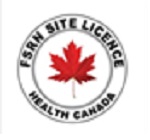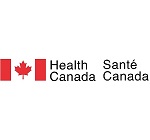NBJ Award: Supply Chain Transparency
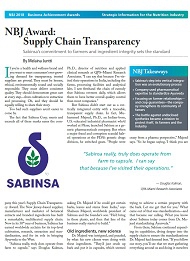
If you’re a health and wellness brand and you want to meet consumers’ ever-growing demand for transparency, trusted suppliers are pivotal. They must be honest, ethical, environmentally sound and socially responsible. They must deliver consistent quality. They should demonstrate great care at every step—from cultivation to extraction and processing. Oh, and they should be equally willing to share their story. Too bad such suppliers aren’t easier to come by. The fact that Sabinsa Corp. meets and Ph.D., director of nutrition and applied clinical research at QPS–Miami Research Associates...
The Advantages of Curcuminoids + BioPerine® Combination
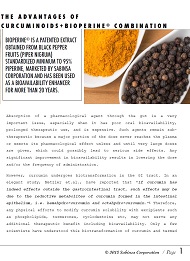
Absorption of a pharmacological agent through the gut is a very important issue, especially when it has poor oral bioavailability, prolonged therapeutic use, and is expensive. Such agents remain sub-therapeutic because a major portion of the dose never reaches the plasma or exerts its pharmacological effect unless and until very large doses are given, which could possibly lead to serious side effects. Any significant improvement in bioavailability results in lowering the dose and/or the frequency of administration. However, curcumin undergoes biotransformation in the GI tract. In an elegant study, Metzler...
Curcumin and Lung Cancer: the Role of microRNAs

Lung cancer is one of the most common types of cancer worldwide and is characterized by a poor prognosis, related to both late diagnosis and lack of effective treatments. In the last years, microRNAs (miRNAs) have been demonstrated to have an important role in tumor microenvironment and immune regulation. These RNAs can be categorized into tumor-suppressor genes, such as let-7 family and miR-34, and oncogenes such as miR-221 and miR-222. Curcumin is a bioactive polyphenol that is documented to have promising anticancer activity, and to be well tolerated in humans...
Tetrahydrocurcumin is More Effective than Curcumin in Preventing Azoxymethane-Induced Colon Carcinogenesis
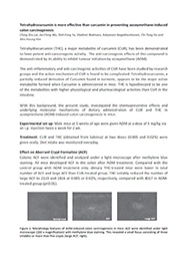
Tetrahydrocurcumin (THC), a major metabolite of curcumin (CUR), has been demonstrated to have potent anti-cancerogenic activity. The anti-carcinogenic effects of this compound is demonstrated by its ability to inhibit tumour initiation by azoxymethane (AOM). The anti-inflammatory and anti-carcinogenic activities of CUR have been studied by research groups and the action mechanism of CUR is found to be complicated. Tetrahydrocurcumin, a partially reduced derivative of Curcumin found in turmeric, appears to be the major active metabolite formed when Curcumin is administered in mice. THC is hypothesized to be one of the metabolites with higher physiological and pharmacological activities than CUR in the intestine.
Bacillus coagulans, Probiotic of Choice
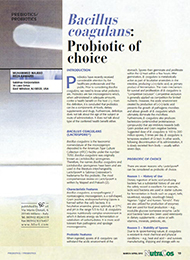
Probiotics have recently received considerable attention by the healthcare professionals and the public. Prior to considering Bacillus coagulans, we need to know what probiotics are. Probiotics are live microorganisms which, when administered in adequate amounts, confer a health benefit on the host. From this definition, it is concluded that probiotics can be a components of foods, dietary supplements and drugs. Furthermore, definition does not talk about the age of the subject or route of administration. It does not talk about type of the conferred health benefit either.
Coconut: Tropic Thunder
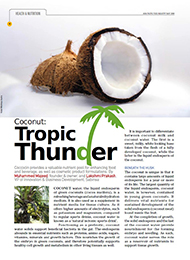
Coconut water, the liquid endosperm of green coconuts (Cocos nucifera), is a refreshing beverage and a natural rehydration medium. It is also used as a supplement in nutrient media for tissue culture. As it offers higher amounts of electrolytes, such as potassium and magnesium, compared to regular sports drinks, coconut water is known as a ‘natural isotonic sports drink’. Functioning as a prebiotic, coconut water solids support beneficial bacteria in the gut. The endosperm abounds in essential nutrients such as proteins, amino acids, sugars, vitamins, minerals and growth factors. This nourishes the growth of the embryo in green coconuts, and therefore potentially supports healthy cell growth and metabolism in other living tissues as well.
Natural ingredients for anti-aging skin care
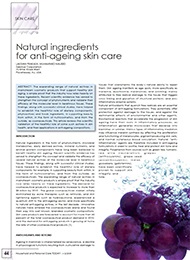
Natural ingredients in the form of phytonutrients, microbial metabolites, dairy derived actives, mineral nutrients, and animal protein components have long been believed to benefit healthy skin ageing. Recent scientific evidence has served to strengthen this concept and validate the efficacy of several natural actives at the molecular level in keratinous tissues. These findings, along with successful clinical studies, have helped to establish the healthful role of dietary components, for example, in supporting beauty from within, in the form of nutricosmetics, and from the outside, as cosmeceuticals. The expanding range of natural actives in mainstream cosmetic products is ample proof that the industry now relies heavily on these ingredients. The demand for cosmeceutical products is expected to increase to more than $8 billion by 2010 .
A randomized, double-blind, placebo-controlled, comparative study
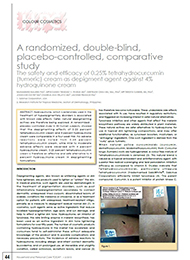
Depigmenting agents, also known as whitening agents or skin tone lighteners, are products used to lighten or “whiten” the skin. In medical practice, such agents are used by dermatologists in the treatment of pigmentation disorders, such as post inflammatory hyperpigmentation secondary to contact dermatitis; widespread Tinea corporis; disseminated lesions of scabies; conditions like melasma or chloasma; or as a treatment option for patients with widespread, treatment-resistant vitiligo, primarily as a measure to depigment residual normal skin (1). In cosmetics, such agents serve as active ingredients that reduce localized hyperpigmentation, age spots, and sun damage, and help to effect a lighter skin tone. Hydroquinone, an inhibitor of tyrosinase, the rate limiting enzyme in melanin biosynthesis, has been used as an active ingredient in skin tone lightening formulations for over fifty years.
Selecting a Quality Contract Manufacturer

With the implementation of federal GMPs (Good Manufacturing Practices) and further interest among consumers and the media in the equality of dietary supplements and related products, marketing firms are turning to respected contract manufacturers to turn out efficacious products that truly deliver the goods. INSIDER took time out to check in with some of the top companies in this field to get their take on the state of the industry and suggestions about selecting a quality partner.
Standardization of Commiphora mukul Extract In Dislipidemia and Cardiovascular Disease
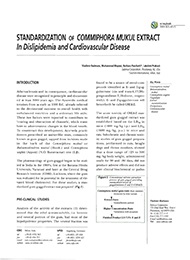
Atherosclerosis and its consequence, cardiovascular disease were recognized in principle and documented at least 3000 years ago. The Ayurvedic medical treatises from as early as 1000 B.C. already referred to the detrimental outcome to overall health with unbalanced nutrition and a sedentary life style. These two factors were reported to contribute to 'coating and obstruction of channels', which translates to atheromatous changes in the blood vessels. To counteract this development, Ayurveda practitioners prescribed an amber-like resin, commonly known as gum guggul, sapped from incisions made in the bark of the Commiphora mukul or Balsamodendron mukul (Hook) and Commiphora wightii (Arpott) (N.O. Burseraceae) tree (1,2).
Stilbenols - A Class of Privileged Structures
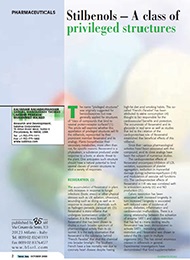
The name “privileged structures” was originally suggested for benzodiazepines but now generally applied for structures of “class of compounds that bind to several protein-receptor surfaces”(1). This article will examine whether this appellation of privileged structures will fit the stilbenols, represented by their prominent member Resveratrol and its analogs. Plants biosynthesize their secondary metabolites, more often than not, for specific reasons. Resveratrol is a phytoalexin, a substance produced under response to a biotic or abiotic threat to the plant.
Weight Management: Indo-Tibetan Alternatives
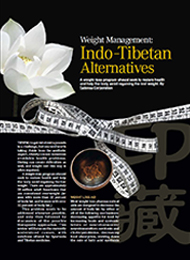
Trying to get rid of extra pounds is a challenge, but one well worth taking. Aside from the aesthetic aspect, obesity causes numerous avoidable health problems. Dieting can create difficulties as well, and weight lost this way is often regained. A weight-loss program should seek to restore health and help the body avoid regaining the lost weight. There are approximately 58 million adult Americans that are considered overweight (i.e: men with more than 22 percent of body fat, and women with over 32 percent of body fat.) This problem needs to be addressed whenever possible, and only then followed by discussion of the possible therapeutic approaches. This review will focus on the currently understood causes, with solutions offered by Ayurveda and Tibetan medicine.
Multifunctional Skin Tone Lighteners from Nature: An Overview
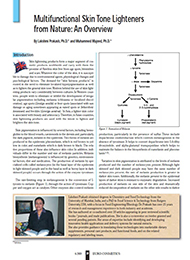
Skin lightening products form a major segment of cosmetic products worldwide and carry with them the promise of flawless skin free from age spots, blemishes and scars. Whatever the color of the skin, it is susceptible to damage due to environmental agents, physiological changes and psychological factors. The demand for “skin fairness products” is rooted in the need to eliminate localized hyperpigmentation as well as to lighten the general skin tone. Motives behind the use of skin lightening products vary considerably between cultures. In Western countries, people wish to eliminate...



